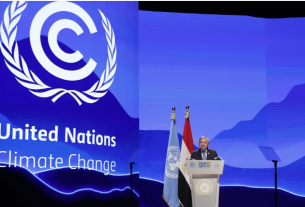
Diana Acconcia, Director for International Affairs and Climate Finance in the Directorate-General for Climate Action of the European Commission, right, at site visit to training on solar PV maintenance targeting unemployed youth, organised by an EU funded project.
The EU works closely with other countries and regions to advance dialogue and cooperation on climate change with the goal of collectively achieving the objectives of the Paris Agreement.
This includes sharing the EU experience of reducing GHG emissions while sustaining economic growth with other countries. In 2023, total net EU GHG emissions were 37% below their 1990 level, with GDP growing by 68% over the same period.
Early next year, all 196 countries under the Paris Agreement are due to submit updated national climate targets and plans for 2035 (so called nationally determined contributions or NDCs) aligned with the common goal of limiting global warming to 1.5°C.
With global emissions continuing to increase in 2023, the importance of ambitious climate targets and implementation plans could not be clearer. As the EU is now responsible for only 6% of global emissions and falling, it is paramount that others act decisively too.
Let’s follow the EU team on three recent visits where they engaged with decision makers about the implementation of current NDCs and the preparations for the new 2035 NDCs.
First stop: Pretoria, South Africa.
In October, officials from the European Commission met with the public sector, business leaders, students and civil society organisations in a warm and dry Pretoria during the European Climate Diplomacy Week. The visit took place few weeks after President Cyril Ramaphosa signed South Africa’s new Climate Change Bill in July 2024, a key reform to step-up action on climate adaptation and mitigation.
South Africa and the EU are both pursuing policies to combat global warming and transition to a low-carbon economy that improves lives and livelihoods. Since 2021, South Africa has been pioneering a Just Energy Transition Partnership (JETP) supported by the EU, France, Germany, the UK and the US.
The ‘just’ means that the people most directly affected by the transition away from coal – the main energy source to produce electricity in South Africa- are not left behind. Making sure that these communities receive adequate support is a key priority both in the EU and South Africa. This can take the form of up- and reskilling of workers, creating new businesses using clean technology, research and innovation, environmental rehabilitation, and job-search assistance.
Initiatives in Europe show that these opportunities can be seized in several ways, for example through the recently established Just Transition Fund and through the flagship initiative Pact for Skills which provided training to more than 3.5 million workers in Europe through 2500 organisations in 2022 and 2023.
A livestreamed roundtable discussion in Pretoria on 4 October, also illustrated how the EU and South Africa are preparing for the submission of their next NDCs, which all parties to the Paris Agreement will have to submit well ahead COP30 in Belem in November 2025. The exchange showed how ambitious climate action can drive green growth, boost job creation, and foster resources for innovation and competitiveness. For example, the EU Emissions Trading System (ETS) – a cornerstone of EU climate policy – has helped reduce emissions from the energy and industry sectors by 47% since 2005, without affecting growth and while raising over EUR 200 billion in revenues re-injected in the EU economy for pursuing the clean transition.
Stop #2: Seoul, the Republic of Korea
The Republic of Korea and Europe may be geographically far away, but thanks to the landmark EU-Korea Green Partnership launched in May last year, cooperation on climate action is vibrant.
On October 11, the EU Delegation to the Republic of Korea hosted a high-level seminar on the 2030 NDC implementation and the preparations for the 2035 NDC, as part of EU Green Diplomacy Week 2024.
This event gathered policymakers, climate experts, and civil society to discuss emission reduction strategies, shared challenges, and next steps for global climate goals. Among the topics discussed, exchanges touched upon the decarbonisation path of energy-intensive industries and how to support them in their transition towards climate neutrality.
In the EU, this is a key priority with a new Clean Industrial Deal on the way in the first 100 days of the new Commission and the energy transition in full swing. Provisional data for 2023 shows that total net GHG emissions in the EU decreased by 8.3% compared with 2022. The energy sector alone saw a record decrease in emissions by a remarkable 18% compared with 2022. Such emission reductions are clearly linked to the acceleration of the energy transition, providing a solid basis for the future and increasing confidence that the EU can meet its climate targets, in a fair and competitive manner.
According to the EU State of the Energy Union Report 2024 published in September, half of the EU’s electricity generation in the first half of 2024, came from renewable sources. Wind surpassed gas generation for the first time in the EU to become the second largest single source of electricity behind nuclear.
The Republic of Korea is one of the many countries supporting the EU-initiated pledge from last year’s COP28 to triple renewable energy capacity globally and double the annual rate of global energy efficiency improvements by 2030. The energy transition is high on the agenda in the cooperation under the Green Partnership, together with other topics, such as carbon pricing, climate adaptation and the greening of shipping.
Stop #3: Brasilia, Brazil
Next year Brazil, as the host of COP30, will take centre stage of the international climate agenda. The host city Belém is located in the north of the country on the edge of the Amazon forest. It is symbolically important as the Amazon is the world’s largest rainforest and an immensely important buffer against global warming owing to its capacity to absorb and store huge amounts of carbon dioxide.
On 17 October, staff from the EU delegation in Brasilia hosted an event with EU Ambassadors and Brazilian climate negotiators to discuss emission reduction strategies, protection of biodiversity and climate finance ahead of COP16 to the UN Convention on Biological Diversity and COP29 on climate. Brazil is a key ally for the EU in the Latin American region in the fight against climate change and both are calling on all countries to submit new NDCs that reflect the highest possible ambition in line with the declaration adopted at COP 28 last year that set out the objective of transitioning away from all fossil fuels to enable the world to reach net zero emissions by 2050.
Discussions were marked by the past year’s tangible effects of the warming climate. In Brazil record droughts, forest fires and dramatic floods in Rio Grande do Sul in March have been linked by scientists to man-made global warming. In Europe, the rainfalls in Poland, Czechia, Austria, Romania, Hungary, Germany and Slovakia this summer were by far the heaviest ever recorded and caused floodings directly affecting almost two million people.
Earlier this year, the European Environment Agency published the first European Climate Risk Assessment (EUCRA) showing that Europe faces urgent climate risks that are growing faster than our societal preparedness. The EU is committed to scaling up climate adaptation efforts by supporting its own regions and also through international cooperation.
To ensure the resilience of our societies and reduce climate risks, European and international policymakers must act now with both rapid emissions cuts and more robust adaptation plans and actions on the ground.
What about the EU’s NDC?
In October 2023, the EU submitted an updated NDC to the UNFCCC that provided more clarity, transparency and understanding on the policies put in place to achieve its target of reducing emissions by at least 55% compared with 1990 levels by 2030.
In February this year, the European Commission presented its recommendation for a 2040 climate target for the EU, as set out in the European Climate Law.
The recommended target is based on a detailed technical analysis of possible pathways to reach climate neutrality by 2050, and on public consultations with EU citizens, industry and stakeholders in 2023.
Following this analysis, the Commission recommended a 90% net greenhouse gas emissions reduction by 2040 compared to 1990 levels. This recommendation is in line with the advice of the European Scientific Advisory Board on Climate Change and the Paris Agreement’s goals.
The 2040 recommendation is the start of a political debate and an open dialogue with all stakeholders in the process. The forthcoming European Commission will make a legislative proposal on this basis, to be agreed with the European Parliament and Member States in the Council, as required under the EU Climate Law. The 2040 target will then be the basis for the new and ambitious EU NDC under the Paris Agreement.


